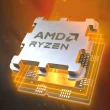Ray tracing is a game rendering technique that simulates the way light interacts with objects to create highly realistic images. This technique traces the path of light rays as they travel through a scene, capturing effects such as reflections, refractions, and shadows with a high degree of realism. Ray tracing has long been used in industries such as film and animation, but its incorporation into game development is relatively recent, driven by advancements in hardware and software technologies.
In traditional rasterisation, the dominant rendering technique in games, images are produced by projecting 3D objects onto a 2D screen. This method is computationally efficient and well-suited for real-time applications like video games. However, rasterisation often falls short in accurately simulating complex light interactions, leading to less realistic visuals. Ray tracing addresses these shortcomings by modeling the physical behavior of light, which results in more lifelike images.
Computational Challenge
The primary challenge has been the high computational cost of ray tracing, making it historically impractical for real-time applications like games. The advent of powerful GPUs and specialised hardware, such as NVIDIA’s RTX series with dedicated ray-tracing cores, has made real-time ray tracing feasible. These advancements enable games to leverage ray tracing for enhanced visual effects while maintaining acceptable performance levels. For example
One of the first major games to implement real-time ray tracing was “Battlefield V” (2018), which utilized NVIDIA’s RTX technology to provide realistic reflections and global illumination. This marked a significant milestone in game development, showcasing the potential of ray tracing to elevate visual fidelity. Following “Battlefield V,” other games like “Control” and “Cyberpunk 2077” have also adopted ray tracing, further pushing the boundaries of game graphics.
Despite its benefits, ray tracing in game development is still in a transitional phase. Developers must balance the improved visual quality with performance considerations, often providing players with options to enable or disable ray tracing features depending on their hardware capabilities. Additionally, hybrid approaches that combine traditional rasterization with ray tracing are commonly used to optimize performance. For instance, some games employ ray tracing selectively for specific effects, such as reflections and shadows, while relying on rasterization for other aspects of rendering.
Game Engine Adoption
Looking forward, the integration of ray tracing into game development is expected to become more prevalent as hardware continues to evolve. The PlayStation 5 and Xbox Series X, for example, both support hardware-accelerated ray tracing, paving the way for broader adoption in the console market. Game engines like Unreal Engine and Unity have also integrated ray tracing support, providing developers with tools to incorporate this technology more seamlessly into their projects.
Ray tracing represents a significant leap forward in the quest for photorealistic graphics in games. While challenges remain, particularly concerning performance optimization, the continued advancement of hardware and software promises to make ray tracing a standard feature in future game development. As the technology matures, players can look forward to increasingly immersive and visually stunning gaming experiences.








